It is good in it's simple raw form.
So more hardy soul's would try the slew series.
(below). "Raw diamond goodness". OR , "a diamond in the rough"
3R/100w =
20hz - 3ppm
1K-4ppm
10k-6ppm
20k-8ppm
NO dirty servo needed. This is symetrical "top to bottom ... as well as
"front to back" - almost no native offset , just need a blocker cap.
R15 from 4.7R to 47R will change the UG pint from 700k - 1.6mhz
and slew from <100V/us to 250+V/us.
This one gives nicely rounded SQ (below 2) and clips nice (below3).
I even want to build this one !
Not too many types of parts , either.
OS
So more hardy soul's would try the slew series.
(below). "Raw diamond goodness". OR , "a diamond in the rough"
3R/100w =
20hz - 3ppm
1K-4ppm
10k-6ppm
20k-8ppm
NO dirty servo needed. This is symetrical "top to bottom ... as well as
"front to back" - almost no native offset , just need a blocker cap.
R15 from 4.7R to 47R will change the UG pint from 700k - 1.6mhz
and slew from <100V/us to 250+V/us.
This one gives nicely rounded SQ (below 2) and clips nice (below3).
I even want to build this one !

Not too many types of parts , either.
OS
Attachments
Think I should make R15 a trimmer , terry ? You could watch the square-waves
change shape as you scope it.
Adjustable slew rate 😎 .
OS
Attachments
How cool is that?!
In the CFA thread it was pointed out that this amp is actually a CFA.
The NFB part of the "H" bridge is just a buffered low Z feedback source
for the input diamond array. The input array (and the NFB) are just
back to back "NX" style amps. behaves JUST like a CFA - but it's a VFA,too.
R15 adjusts the current feedback , just like using more current in a typical
CFA resistor network.
OS
I think it should be a *very bad* idea.Think I should make R15 a trimmer , terry ?
In a closed loop amplifier, the feedback path is critical and need the most linear parts you can find. IE high quality resistances.
One of the reasons i prefer CFAs and why i don't like too much this arrangement where the feedback has to across imperfect active stages with phase turns and bandwidth and slew rates limitations.
The positive side is it keeps the expansive behavior of the CFAs.
A suppose careful listening will determine in witch character direction goes this amp. VFA or CFA ?
the feedback path is critical and need the most linear parts you can find. IE high quality resistances.
Define high quality resistance?
Bigger resistor has lower noise. Checked. But I prefer to use my 1/4W tantalum resistors than my 3W caddock resistors.
Feedback path surrounded by ground plane. Checked.
Anything else? Is thin copper line okay? 😀
I think it should be a *very bad* idea.
In a closed loop amplifier, the feedback path is critical and need the most linear parts you can find. IE high quality resistances.
One of the reasons i prefer CFAs and why i don't like too much this arrangement where the feedback has to across imperfect active stages with phase turns and bandwidth and slew rates limitations.
The positive side is it keeps the expansive behavior of the CFAs.
A suppose careful listening will determine in witch character direction goes this amp. VFA or CFA ?
I suppose a choice of fixed resistors for R15 (the bridge) would be fine.
A builder could 🙄 try -
10R - for 1.6mhz UG and +250V/uS slew .... or
100R - 730khz typical VFA UG and a lowly <80V/uS.
The phase margin is (at it's worst-below) 75+ degrees. The squarewave just
begins to overshoot at 4.7R for the bridge (2mhz UG). 15-22R seems to be
the "sweet spot".
I might call it the "EFA" (excellent flippin' amp) like the adcom GFA.
Runs like the "spooky" , as far as it's stability. A worst case 10ppm 20k amp.
There is almost no phase delay (turns ?) <20 nanoseconds through the diamond, the "jewels" are smokin' FAST ! 😀
PS - don't believe me , play with it (below .asc).
EDIT - this one allows for a CFA experience without the thermal distortion of 50ma + going through 3W resistors. Last pix- 400V slew !!
OS
Attachments
Last edited:
Fast-track
Warm up the irons !
I'm doing this one.
Should be pretty like a butterfly (2 jumpers -diamond X-overs)
OS
Warm up the irons !
I'm doing this one.
Should be pretty like a butterfly (2 jumpers -diamond X-overs)
OS
Attachments
Last edited:
OS,
These latest amps, the DDHS versions, where do they fit in in your plan here? Are they supposed to be your latest and best designs or are they just another branch of your Input section explorations? I'm trying to keep up with what fits where. I for some reason thought that the Krypton designs were going to be your ultimate implementations of a CFA and VFA from all you have discovered. This is getting confusing!
These latest amps, the DDHS versions, where do they fit in in your plan here? Are they supposed to be your latest and best designs or are they just another branch of your Input section explorations? I'm trying to keep up with what fits where. I for some reason thought that the Krypton designs were going to be your ultimate implementations of a CFA and VFA from all you have discovered. This is getting confusing!
Not noisy (too much), not magnetic, not inductive, not with a too important temperature coefficient and, if possible, oversized.Define high quality resistance?
OS,
These latest amps, the DDHS versions, where do they fit in in your plan here? Are they supposed to be your latest and best designs or are they just another branch of your Input section explorations? I'm trying to keep up with what fits where. I for some reason thought that the Krypton designs were going to be your ultimate implementations of a CFA and VFA from all you have discovered. This is getting confusing!
This one is (neither or either) a CFA or a VFA.
It could be a "spooky 2" as well. Works in a similar manner.
After seeing that OPA660 - I could not resist.
There is ALWAYS more to discover , John Curl discovered the "H" bridge
long ago (his amps/preamps).
I might hook up the "super VAS" to this one , it is not excessively "gained"
like the Kypton -V and has C-B standard symmetric compensation.
There is a good possibility this could outperform ANY CFA in speed and
ANY VFA in the low THD arena. 😱
PS- it's close now
-<10ppm THD20k 4R 100w
-close to 400V/us slew
- -90psrr and very little offset.
- simple as hell !! 16 semis/ 6 diodes /9 caps/30 resistors
Does not need a servo - a great "newbie" IPS.
And no "sonic signature".Not noisy (too much), not magnetic, not inductive, not with a too important temperature coefficient and, if possible, oversized.

Thanks OS,
So could you call this a hybrid C-VFA? I think from what I have been following you can combine the attributes and use both V and C feedback in a single topology design, or perhaps I am not understanding the details enough to quite get what you are doing?
So could you call this a hybrid C-VFA? I think from what I have been following you can combine the attributes and use both V and C feedback in a single topology design, or perhaps I am not understanding the details enough to quite get what you are doing?
Thanks OS,
So could you call this a hybrid C-VFA? I think from what I have been following you can combine the attributes and use both V and C feedback in a single topology design, or perhaps I am not understanding the details enough to quite get what you are doing?
If you look at the "H" bridge circuit , the input "side" is a standard 2 stage
CFA. Just hook your low Z resistor network to the emitter resistors of Q5/7
and you have that "standard CFA" (the OPA660 allowed this , too)
The "NFB side" Q3/4 -Q6/8 form a "fake" or virtual CFA feedback path buffered by the high Z diamond.
This nearly eliminates the offset (CFA trait 🙁 ) , the poor PSRR (CFA) ,
and the high wattage resistors.
I tried to go faster... <500v/us is the max for this amp.
The NFB diamond(Q3/4) IS the slew limiting factor -esperado 😀 ,
as one-half the amp - (the true CFA stage can go 600V+/uS).
ALL designs are compromises ! - 100V slew = +20db psrr , NO big resistors ,
and better offset/THD. A fair trade , if you ask me. 🙂
EDIT - then , I was pondering whether the output's interaction with the speakers in
a TRUE CFA is fed back as a NFB "artifact". This does not happen here - just a voltage signal.
OS
Last edited:
And no "sonic signature".
I did not mean "ANY" amp , Ed. Shurely , not yours !! 😀
But , not bad for a small fistfull of cheap parts.
OS
Hi Pete,
You were just in time with post #5265, otherwise I had to disagree. 😉
> "not bad for a small fistfull of cheap parts" Thanks!
Cheers, E.
You were just in time with post #5265, otherwise I had to disagree. 😉
> "not bad for a small fistfull of cheap parts" Thanks!
Cheers, E.
Yes , cheap with low support.
This is why I am still tinkering with your TIS and "fast-tracking"
this input stage.
The TIS really flies , but with all those comp. paths and many
semi's ... I would have to think about all the questions that would
arise.
My 3 simple ones , the LIN ,the CFA ,and the leach - no questions.
Add some cascodes/superpairs , lead and lag ..... 😕 .
.
😀
OS
This is why I am still tinkering with your TIS and "fast-tracking"
this input stage.
The TIS really flies , but with all those comp. paths and many
semi's ... I would have to think about all the questions that would
arise.
My 3 simple ones , the LIN ,the CFA ,and the leach - no questions.
Add some cascodes/superpairs , lead and lag ..... 😕
 .
.😀
OS
- Home
- Amplifiers
- Solid State
- Slewmaster - CFA vs. VFA "Rumble"
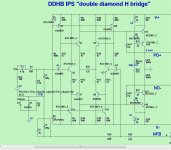
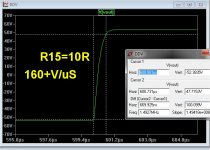
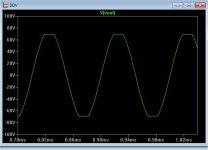

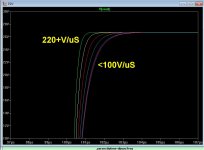
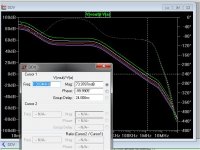
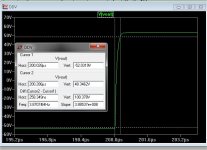
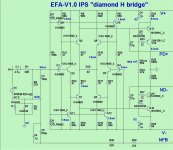
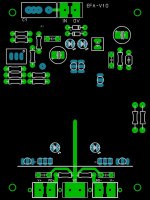
 before you get it going good. Thanks.
before you get it going good. Thanks.